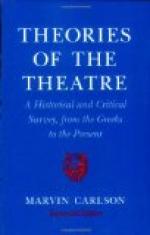The first type, which is represented by Greek tragedy, displays the individual in conflict with Fate, an inscrutable power dominating alike the actions of men and of gods. It is the God of the gods,—the destiny of which they are the instruments and ministers. Through irreverence, through vainglory, through disobedience, through weakness, the tragic hero becomes entangled in the meshes that Fate sets for the unwary; he struggles and struggles to get free, but his efforts are necessarily of no avail. He has transgressed the law of laws, and he is therefore doomed to inevitable agony. Because of this superhuman aspect of the tragic struggle, the Greek drama was religious in tone, and stimulated in the spectator the reverent and lofty mood of awe.
The second type of tragedy, which is represented by the great Elizabethan drama, displays the individual foredoomed to failure, no longer because of the preponderant power of destiny, but because of certain defects inherent in his own nature. The Fate of the Greeks has become humanised and made subjective. Christopher Marlowe was the first of the world’s dramatists thus to set the God of all the gods within the soul itself of the man who suffers and contends and dies. But he imagined only one phase of the new and epoch-making tragic theme that he discovered. The one thing that he accomplished was to depict the ruin of an heroic nature through an insatiable ambition for supremacy, doomed by its own vastitude to defeat itself,—supremacy of conquest and dominion with Tamburlaine, supremacy of knowledge with Dr. Faustus, supremacy of wealth with Barabas, the Jew of Malta. Shakespeare, with his wider mind, presented many other phases of this new type of tragic theme. Macbeth is destroyed by vaulting ambition that o’erleaps itself; Hamlet is ruined by irresoluteness and contemplative procrastination. If Othello were not overtrustful, if Lear were not decadent in senility, they would not be doomed to die in the conflict that confronts them. They fall self-ruined, self-destroyed. This second type of tragedy is less lofty and religious than the first; but it is more human, and therefore, to the spectator, more poignant. We learn more about God by watching the annihilation of an individual by Fate; but we learn more about Man by watching the annihilation of an individual by himself. Greek tragedy sends our souls through the invisible; but Elizabethan tragedy answers, “Thou thyself art Heaven and Hell.”
The third type of tragedy is represented by the modern social drama. In this the individual is displayed in conflict with his environment; and the drama deals with the mighty war between personal character and social conditions. The Greek hero struggles with the superhuman; the Elizabethan hero struggles with himself; the modern hero struggles with the world. Dr. Stockmann, in Ibsen’s An Enemy of the People, is perhaps the most definitive example of the type, although the play in which he appears is not, strictly speaking, a tragedy. He says that he is the strongest man on earth because he stands most alone. On the one side are the legions of society; on the other side a man. This is such stuff as modern plays are made of.




